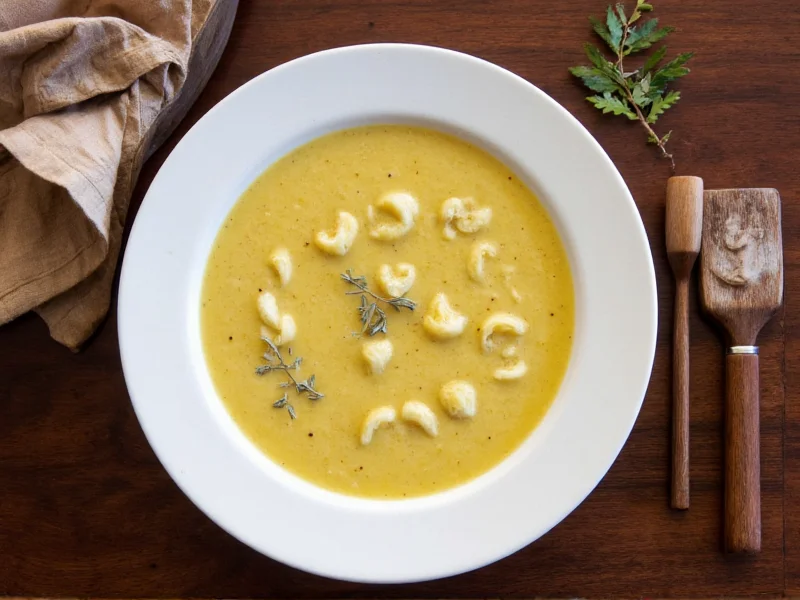The Essential Guide to Perfect Celeriac Soup
When you're searching for how to make celeriac soup from scratch, understanding this unique ingredient is your first step to culinary success. Celeriac, also called celery root, is a knobby bulb that grows underground and belongs to the same family as celery stalks. Unlike its stringy green counterpart, celeriac offers a concentrated celery flavor with subtle nutty undertones that shine in soups.
Why Celeriac Makes Exceptional Soup
Celeriac's high starch content creates a naturally creamy texture when cooked and pureed, eliminating the need for heavy cream in many recipes. This makes it ideal for creamy celeriac soup without cream variations that maintain richness while being lighter. The vegetable's earthy flavor profile absorbs complementary ingredients beautifully, whether you're creating a simple weeknight meal or an elegant dinner party starter.
Mastering Celeriac Preparation Techniques
Working with celeriac can be challenging due to its irregular shape and tough outer layer. Follow these professional celeriac soup preparation techniques for best results:
| Preparation Step | Professional Tip | Time-Saving Alternative |
|---|---|---|
| Peeling | Use a sharp chef's knife instead of a vegetable peeler for better control on uneven surfaces | Soak in acidulated water (1 tbsp lemon juice per quart) to prevent browning while prepping |
| Cutting | Cut into uniform 1-inch cubes for even cooking | Food processor with slicing attachment (pulse carefully) |
| Storage | Submerge cut pieces in water with lemon juice in airtight container | Pre-cut celeriac available at specialty grocers (more expensive) |
Building Flavor Depth in Your Soup
The foundation of exceptional celeriac soup for winter meals starts with proper flavor layering. Begin by sweating onions and garlic in olive oil until translucent but not browned—this builds sweetness without bitterness. Add chopped celeriac and a supporting vegetable like potato (for extra creaminess) or apple (for subtle sweetness). Pour in vegetable broth gradually, allowing the vegetables to absorb flavors at each addition.
For healthy celeriac soup variations, consider these additions at different stages:
- Early cooking: Fresh thyme, bay leaves, or a Parmesan rind
- Middle cooking: Leeks or fennel for complexity
- Finishing: Lemon zest, fresh herbs, or a drizzle of truffle oil
Avoiding Common Celeriac Soup Mistakes
Even experienced cooks make these errors when preparing the best celeriac soup recipe with potatoes:
- Undercooking the celeriac: Unlike potatoes, celeriac needs thorough cooking (25-30 minutes) to eliminate any raw flavor and achieve proper texture for blending
- Over-salting early: Season gradually, especially if using store-bought broth which often contains significant sodium
- Rushing the blending process: Use an immersion blender carefully or blend in batches with the center cap removed to prevent pressure buildup
- Skipping the finishing acid: A splash of lemon juice or vinegar just before serving brightens flavors dramatically
Dietary Adaptations for Every Cook
Whether you're cooking for specific dietary needs or simply experimenting, these celeriac soup variations maintain integrity while accommodating preferences:
- Vegan version: Use vegetable broth and finish with coconut milk instead of cream. Add nutritional yeast for umami depth
- Low-carb option: Replace potatoes with cauliflower for similar creaminess with fewer carbohydrates
- Apple-celeriac fusion: Add 1 diced apple with the celeriac for natural sweetness that complements the earthy notes
- Protein boost: Stir in white beans after blending for added protein and fiber
Serving and Storage Recommendations
For optimal enjoyment of your celeriac soup preparation, follow these professional serving suggestions:
- Temperature: Serve hot but not boiling—celeriac soup's delicate flavors shine at 160-170°F (71-77°C)
- Garnishes: Crispy fried shallots, fresh chives, or toasted pumpkin seeds add contrasting texture
- Pairings: Complement with crusty bread, a simple green salad, or roasted root vegetables
Proper storage extends your soup's life significantly. Cool completely before transferring to airtight containers. Refrigerated celeriac soup storage tips include:
- Refrigerate for up to 4 days
- Freeze in portion-sized containers for up to 3 months
- When reheating, add a splash of broth if the soup has thickened too much
Nutritional Benefits of Celeriac
Beyond its culinary appeal, celeriac offers impressive health benefits that make your healthy celeriac soup both delicious and nutritious. One cup of cooked celeriac provides:
- 45 calories with 10g of fiber (40% of daily value)
- Rich in vitamin K (37% DV), essential for blood clotting and bone health
- Excellent source of phosphorus and vitamin B6
- Naturally low in fat and sodium
- Contains antioxidants like flavonoids and vitamin C
These nutrients make celeriac soup particularly valuable during cold and flu season, supporting immune function while being gentle on digestion. The high fiber content promotes satiety, making it an excellent choice for weight management without sacrificing flavor or satisfaction.











 浙公网安备
33010002000092号
浙公网安备
33010002000092号 浙B2-20120091-4
浙B2-20120091-4